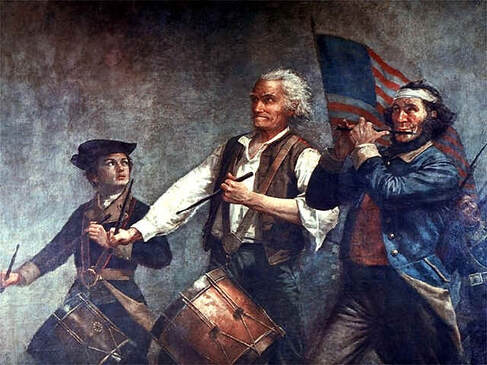|
With our country celebrating its independence from Great Britain, it seems appropriate to remember why we light fireworks, grill hot dogs, and display our national flag. It took teams of courageous colonists to build effective lines of defense in pursuit of a dream. It was more than taxation without representation. It was freedom of religion & speech and fighting for something in which they believed.
Keep in mind the colonists in America did not necessarily want to engage in warfare. They simply wanted taxation with representation. The colonists were considered British citizens so they felt it was only right to have representation in Parliament. However, King George III disagreed and kept a tight reign over the British colonists in America, citing he would continue harassing the rebels until essentially they would grow remorseful and abandon their revolution. We all know the saying, “There is no ‘I’ in teamwork.” In some respects, I disagree. As I mentioned above, individuals constitute a team. Individuals have personalities and skills, some which can be vastly different. When in the workplace, we have to consider the fact individual personalities can be hard to overcome and placing each person in a role using their strengths is essential. This is where the mutual goal comes into play and individuals must set aside their egos and mesh with one another to accomplish this goal. Think back to the American Revolution. That’s a word with HUGE implications. Merriam-Webster defines revolution as: a fundamental change in political organization, especially the overthrow or renunciation of one government or ruler and the substitution of another by the governed. Thankfully, the United States will not likely see another revolution. However, there are ongoing revolutions in smaller countries around the globe. These revolutions are often fought by groups of individuals who had never met before but who came together for a common cause. Individuals join local militia forces, typically with zero military experience. During the American Revolution, commanders borrowed from both French and British tactical strategies to have a jumping off point for training men (and boys) to be soldiers. Commanders faced the difficulty of not only training farmers to be soldiers, but to also teach them tactics. Imagine farmers with muskets learning how to use the weapon for warfare. They were not hunting deer; they were defending their cause. This would mean killing fellow British citizens from England. But each man joined the effort to realize the common dream. Fast-forward nearly 250 years. Today our country has immense freedom. Corporations and organizations continue popping up across the nation. However, they are not immune from dissension when it comes to achieving goals. It doesn’t matter what the goal is. It can be creating a mission and vision statement, developing policies and procedures, or even deciding whether or not to merge with another company. Big or small, you can guarantee not everyone will have the same ideas or approach. This is where the rubber meets the road. Will everyone come together, putting aside individuality for agreement? Let’s break it down further. Because most of my HR background is healthcare, I’ll use the example of a hospital. What would happen if nurses and physicians did not abide by federal and state regulations or they bucked policy and procedures in the event of a Code Blue? The patient would receive terrible care and perhaps even succumb to their ailments. Or what would happen if a fire alarm sounded and nobody knew what to do, everyone acted in his or her own best interest? Leadership must take responsibility for ensuring staff members are acting as a cohesive group. Leaders should be open to suggestions from staff and allow some democracy in decisions made on behalf of the team. This can’t always be done—some regulations are black and white. But when individuals within a team have a voice, they will use their voice to sound ideas, often ideas outside the box. After all, they are the ones doing the daily work and they have a better understanding of how to improve as a team. Employees who feel valued are more apt to work as a team and encourage others to do the same. In a hospital, that translates to better patient care and outcomes. Building a cohesive team means leaders must also be team members. Nothing rubs me the wrong way more than someone who spouts, “That’s not my job.” It most certainly is. We are all on the same team. When leaders and managers roll up their sleeves, they are demonstrating this and announcing they espouse the very foundation of individuals joining as one cause for one goal. I am thankful to live in a society where teamwork is at the core of who we are and each team member is/was necessary to hoist the star spangled banner. Personally, I am grateful for the sacrifice my 5x great-grandfather William Bassett made when he fought with the Third Continental Light Dragoon in the late 1770s. He managed to escape during the Tappan Massacre and began receiving a military pension nearly 50 years later. If not for this individual soldier working together with fellow militiamen, the dream of freedom would have lain tattered and torn on the battlefield.
0 Comments
Leave a Reply. |
CreatorCreator: That makes me sound all powerful. I suppose I am in many ways. Hi! My name's Amy and I've been practicing HR for twelve years now. No big deal. I am here to offer fresh perspective on HR topics and topics about the world we live in and life in general. Archives
February 2022
Categories |

 RSS Feed
RSS Feed